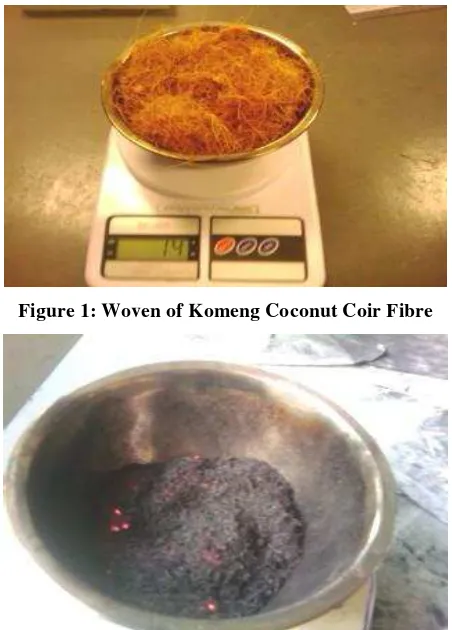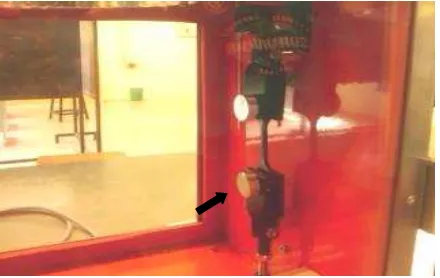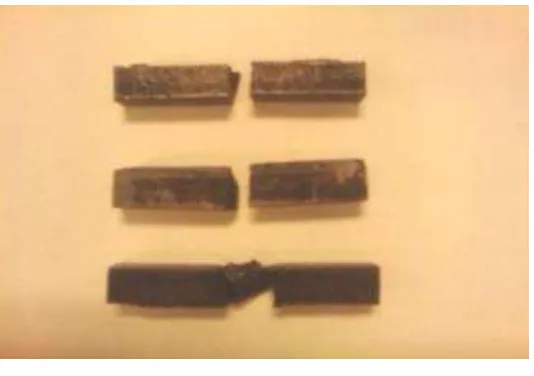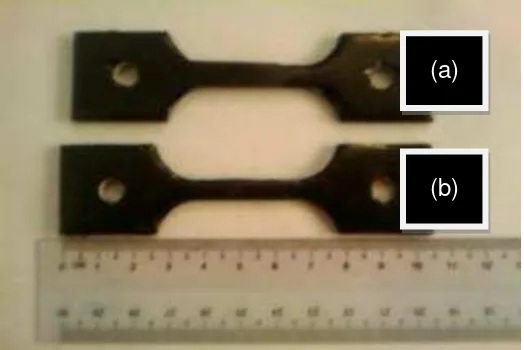MECHANICAL PROPERTIES OF COCONUT CARBON FIBRE/EPOXY COMPOSITE
MATERIAL
M. M. B. H. SALLEH1, Z. SALLEH2, M. S. ROSDI3 & S. M SAPUAN4
1,2,3UniversityKuala Lumpur, Applied Science & Advanced Technology Section, Malaysian Institute of Marine
Engineering Technology, Dataran Industry Technology Kejuruteraan Marin, Bandar Teknologi Maritim, Jalan Pantai Remis, Lumut Perak, Kuala Lumpur, Malaysia
4Department of Mechanical and Manufacturing Engineering, University Putra Malaysia, Serdang, Selangor, Malaysia
ABSTRACT
In this research, the carbon fibre developed from komeng coconut coir fibre was reinforced with epoxy resin with difference weight percentage (0wt.%, 2.5wt.%,5wt%,7.5wt% and 10wt%) of carbon fibres. All the samples were prepared using the silicon rubber mould (SRM) to produces the specimen with the rectangular shape and dumbbell shape. The mechanical properties using Izod impact test (ASTM 256) and Creep Test (ASTM D2990) were investigated. The characteristics of all composite materials was also investigated and discussed.
KEYWORDS:
Komeng Coconut, Carbon Fibre, Silicon Rubber Mould, Izod Un-Notched Impact Test, Work of Fracture(WOF)
INTRODUCTION
An important development in the field of materials engineering applications is the design of new materials to meet stringent requirements relating to energy conservation, safety and anti-pollution standards. Plastic materials, both reinforced and none reinforced, are potentially well-suited to satisfy these new requirements, but the cost and performance of plastics components depends on the strength and process involved. Carbon fibre reinforced thermoplastics are advanced materials for future high-performance composites. Combination of characteristics such as light-weight, corrosion resistance, low to moderate cost, high thermal stability and easy material process ability, make them attractive for many applications especially in automotive industry [1]. High strength, stiffness, and toughness as well as lightness are the most important characteristics of an ideal engineering material. Conventional engineering materials i.e., metals and their alloys are strong and tough, but not light. Certain plastic materials are light but lack strength. Carbon fibre reinforced composites have all the ideal properties, leading to their rapid development and successful use for many applications over the last decade. Our relentless concern on carbon dioxide emissions and petroleum reserves transpire considerable interest in technologies that reduce fuel consumption in passenger cars. In the area of vehicle design, body weight is the most important target for improvement. It has been demonstrated that thermoplastic composites provide a real option for horizontal parts in passenger cars [2-9]. A good case in point is a bonnet, where traditionally a steel skin is used. The material required for this application has to be recyclable, have good impact strength, low weight and high stiffness. It also requires an extremely low coefficient of thermal expansion (CTE) and the ability to bond with steel [10]. Higher utilization of low-density materials such as polymer composites is a prerequisite for the light weight vehicle of the future. Epoxy resins (ER) are one of the most important classes of thermosetting polymers which are widely used as matrices for fibre-reinforced composite materials and as structural adhesives [11–16]. They are amorphous, highly cross-linked polymers and this structure results in these materials possessing various desirable properties such as high tensile strength and modulus, Vol. 2, Issue 3, July 2013, 55-62
stability, high performance thermoplastics have been employed to toughen epoxy resins in recent years [11,12].
Various research on the application of natural fillers and fibres in composites like pineapple, sisal, coconut coir, jute, palm, cotton, rice husk, bamboo, and wood as the reinforcements in composites have been reported in the literature. Luo and Netravali [21] studied the tensile and flexural properties of the green composites with different pineapple fibre content and compared with the virgin resin. Sisal fibre is fairly coarse and inflexible. It has good strength, durability, ability to stretch, affinity for certain dyestuffs and resistance to deterioration in seawater. Sisal ropes and twines are widely used for marine, agricultural, shipping, and general industrial use. Belmeres et al. [22] found that sisal, henequen, and palm
fibre have very similar physical, chemical, and tensile properties. Cazaurang et al. [23] carried out a systematic study on
the properties of henequen fibre and pointed out that these fibres have mechanical properties that are suitable for reinforcing thermoplastic resins. Ahmed et al. [24] carried out research work on filament wound cotton fibre reinforced for
reinforcing high density polyethylene (HDPE) resin. Khalid et al. [25] also studied the use of cotton fibre reinforced epoxy
composites along with glass fibre reinforced polymers. Fuad et al. [26] investigated the new type wood-based filler derived
from oil palm wood flour (OPWF) for bio-based thermoplastics composites by thermogravimetric analysis and the results are very promising. Schneider and Karmaker [27] developed composites using jute and kenaf fibre and polypropylene resins and they reported that jute fibre provides better mechanical properties than kenaf fibre.
Coconut (Cocos Nucifera) is one of the most important natural fillers produced in tropical countries like Malaysia, Indonesia, Thailand, and Sri Lanka. Several researches have been devoted to the use of other natural fillers in composites in the recent past. Coconut filler is a potential candidate for the development of new composites because of their high strength and modulus properties. Composites of high strength coconut filler can be used in the broad range of applications as, building materials, marine cordage, fishnets, furniture, and other household appliances. From the review of the literature, there are a few reports regarding the coconut carbon fibre composite material for engineering application especially from komeng coconut carbon coir fibre. It was reported that komeng coconut coir fibre shown the good strength compared with other types of coconut coir fibres [28]. The objective of this paper is to study the impact test and creep test properties of komeng coconut carbon coir fibre/epoxy resin composites.
METHODOLOGY
Preparation of Materials
Figure 1: Woven of Komeng Coconut Coir Fibre
Figure 2: Carbon Coir Fibre of Komeng Coconut Preparation of Komeng Coconut Carbon Fibre/Epoxy Composite Materials
Moulds used in this study were made from silicone rubber mould (SRM). Two types of sample were prepared one sample for Izod impact test and another sample for the creep test. The open mould type was used with rectangular shape according standard (ASTM D256) for Izod impact test and dumbbell-shape samples follow the standard ASTM D2099 for creep test. Total number of samples for each mould can produce maximum until 15 specimens in one time. Each mould has a cavity to accommodate the composite samples. Epoxy and hardener were mixed in a container and stirred well for 5–7 minutes. Before the mixture was placed inside the silicon rubber mould (SRM mould), the mould was initially polished with a release agent or wax to prevent the composites from sticking onto the mould upon removal. Finally, the mixture between komeng coconut carbon coir fibre and epoxy resins were poured into the mould and left at room temperature for 24 hours until the mixture was hardened. Figure 3(a) shows the Open Silicon Rubber Mould (SRM mould) filler with komeng coconut carbon coir fibre/epoxy resin composite for Izod impact test and Figure 3(b) mould for creep test.
Figure 3(b): SRM Open Mould for Creep Test Samples Mechanical Properties Using Izod Impact and Creep Test
In order to measure the work of fracture (WOF), the Izod impact test was carried out. Impact bars were obtained by cutting specimens with rectangular shapes. These rectangular specimens has dimension of thickness 3 mm, width 12 mm and length 62 mm according to ASTM D256. Izod impact tests were conducted on an Izod impact tester using 7 replicates for each specimen. The test was carried out with impact energy of 5 J and a span length of 60 mm at angle 30o. The average value of un-notched Izod impact energy was obtained from each group of 7 specimens. Figure 4 show the overview specimen located at Izod impact tester. When a material like steel is plastically deformed at ambient temperatures, its strength is increased due to work hardening. This work hardening effectively prevents any further deformation from taking place if the stress remains approximately constant. Annealing the deformed steel at an elevated temperature removes the work hardening and restores the steel to its original condition. However, if the steel is plastically deformed at an elevated temperature, then both work hardening and annealing take place simultaneously. A consequence of this is that steel under a constant stress at an elevated temperature will continuously deform with time, that is, it is said
to "creep".The SM106 Creep Measurement Apparatus shows at Figure 5 whereas location of specimen at sample holder.
Figure 4: Specimen at Sample Holder of Izod Impact Tester
RESULTS AND DISCUSSIONS
The WOF of komeng coconut carbon fibre/epoxy resin composites based on the un-notched Izod impact test is presented in Figure 6 and show that the un- notched impact energy increased by the addition of carbon fibres to epoxy resin. It indicated that the fibres played a dominant role in terms of fracture energy. On the other hand, the composite impact energy would increase with increased average komeng coconut carbon fibre contents (0 wt%, 2.5 wt%, 5.0 wt%, 7.5 wt% and 10 wt%). It was confirmed that with 10 wt% carbon fibre content shows the highest impact strength among all the samples. Figure 7 shows a photo of specimen with 7.5wt%carbon fibre after performed Izod impact test. All the samples showed that the location of fracture is always in the middle of the specimen.
It was agreed with previous report stated that mechanical properties of the natural fibre composites depend on several factors such as the stress–strain behaviours of fibre and matrix phases, the phase volume fractions, the fibre concentration, the distribution and orientation of the fibre or fillers relative to one another [29]. The low impact strength of shorter fibres composites may also be due to the presence of too many fibre ends within the composites, which could induce crack initiation, hence increased potential of the composite failure.
Figure 6: Izod Impact Testing for Different Angle with Difference wt% of Carbon Fibre
Figure 7: Photo of Specimen after Izod Impact Test
Figure 8: Creep Test Elongation-Time (min.)
The impact property of a material is its capacity to absorb and dissipate energies under impact or shock loading. The impact performance of fibre-reinforced composites depends on many factors including the nature of the constituent, fibre/matrix interface, the construction and geometry of the composite and test conditions. The impact failure of a composite occurs by factors like matrix fracture, fibre/matrix de-bonding and fibre pull out. Even though, fibre pull out is found to be an important energy dissipation mechanism in fibre reinforced composites [30]. During creep test the load capacity 2N has been used with temperature 60C. The applied load transferred by shear to fibres may exceed the fibre/matrix interfacial bond strength and de-bonding occurs. When the stress level exceeds the fibre strength, fibre fractured occurs at end of elongation with time 7 minutes. High strain rates or impact loads may be expected in many engineering applications of composite materials. The suitability of a composite for such applications should therefore be determined not only by usual design parameters, but by its impact or energy absorbing properties. Figure 9 shows the photo of specimen after creep testing where (a) Initial length of specimen and (b) Length after the creep testing. The initial length was 115cm and the final length was 118cm, an increase of 3cm.
Figure 9: The Differences in Length of Specimens after Creep Testing
CONCLUSIONS
The investigation on mechanical properties of komeng coconut carbon fibre reinforced epoxy composites achieves the following results. In this work the successful fabrication of a komeng coconut carbon fibre reinforced epoxy composites with different komeng coconut carbon fibre weight percentage is possible to produce by using SRM mould. Then, it can be seen that the elongation of samples are increasing with the increased in komeng coconut carbon fibre
(a)
contents started from 2.5wt%,5.0 wt%, 7.5 wt% and 10 wt%. From the result, specimen with 10 wt% give tremendous impact strength compared with other samples. While from the creep testing result, it also can be seen that the material will continue to deform slowly with time indefinitely or until rupture or yielding causes failure. From the Fig.7, it was shown the primary region is the early stage of loading when the creep rate decreases rapidly with time. Then it reached a steady state which is called the secondary creep stage followed by a rapid increase (tertiary stage) and fracture area.
REFERENCES
1. L.A. Carlson, 1991. Thermoplastic composite materials. Florida Atlantic University.
2. MG. Bader, JF. Collins, 1983. The effect of fibre-interface and processing variables on the mechanical properties of glass-fibre filled nylon 6. Fibre Sci Technol 18:pp217–221.
3. H. Bijsterbosch, RJ. Gaymans, 1995. Polyamide 6-long glass fibre injection mouldings. Polym Compos 16: pp363–3699
4. L. Biolzi, L. Castellani, I. Pitacco, 1994. On the mechanical response of short fibre reinforced polymer composites. Journal Material Science 29: pp2507–2512
5. PT. Curtis, MG. Bader, JE. Bailey, 1978. The stiffness and strength of a polyamide thermoplastic reinforced with glass and carbon fibres. J Mater Sci;13: pp377–390
6. J. Denault, T. Vu-Khanh, B. Foster, 1989. Tensile properties of injection moulded long fibre thermoplastic composites.Polym Compos 10: pp313–321
7. S.-Y. Fua,, B. Laukeb, E. Ma¨derb, C.-Y. Yuea, X. Hua, 2000. Tensile properties of short -glass-fibre- and short carbon-fibre-reinforced polypropylene composites Composites: Part A 31: pp1117–1125
8. R. Weiss, 1991. Fabrication techniques for thermoplastic composites, Cryogenics, 319-322.
9. S.Y. Fua, B. Lauke, E. MaÈder, X. Hu , C.Y. Yue, 1999. Fracture resistance of short-glass-fibre-reinforced and short carbon-fibre-reinforced polypropylene under Charpy impact load and its dependence on processing; Journal of Materials Processing Technology 89-90:pp501-507
10. Reinforced Plastics© Copyright 2005, Elsevier Ltd, 2005. www.reinforcedplastics.com
11. Z. Zhikai, Z. Sixun, H. Jinyu C. Xingguo, G. Qipeng, and W. Jun, Phase Behavior and Mechanical Properties of Epoxy Resin Containing Phenolphthalein Poly ether ether Ketone, Journal of Polymer, 39 (5), (1997), pp. 1075–
1080.
12. H. Shangjin, S. Keyu, B. Jie, Z. Zengkun, L. Liang, D. Zongjie and Z. Baolong, “Studies on the Properties of Epoxy Resins Modified with Chain-Extended Ureas” , Journal of Polymer, 42 (2001), pp. 9641–9647.
13. W. G. Potter, Epoxide Resins, New York: Springer, 1970.
14. C. A. May and G. Y. Tanaka, “Epoxy Resin Chemistry and Technology”. New York: Marcel Dekker, 1973.
15. R. S. Bauer (ed.), “Epoxy Resin Chemistry I”, ACS Symposium Series, no. 114. Washington, DC: American
Chemical Society,1979.
16. R. S. Bauer (ed.), “Epoxy Resin Chemistry II”, ACS Symposium Series, no. 201. Washington, DC: American
19. J. S. Riffle, I. Yilgor, A. K. Banthia, C. Tran, G. L. Wilkes, and J. E. McGrath in “Epoxy resin chemistry”, (ed. R. S. Bauer), ACS Symposium Series no. 201. Washington, DC: American Chemical Society, 1983, p. 21.
20. C. B. Bucknall, Toughened Plastics, London: Applied Science, 1977.
21. S. Luo and A.N. Netravali, “Mechanical and Thermal Properties of Environmentally Friendly “Green” Composites Made from Pineapple Leaf Fibres and Poly (hydroxybutyrate-co-valerate) Resin”, Polymer Composites, 20 (3). (1999), pp. 367–378.
22. H. Belmares, A. Barrera, and M. Monjaras, “New Composite Materials from Natural Hard fibres. Part 2. Fatigue Studies and a Novel Fatigue Degradation Model”, Industrial Engineering Chemical Product Research and Development, 22 (1983), pp. 643–652.
23. M. Cazaurang, P. Herrera, I. Gonzalez, and V.M. Aguilar, “Physical and Mechanical Properties of Henequen Fibres”, Journal of Applied Polymer Sciences, 43 (1991), pp. 749–756.
24. E.M. Ahmed, B. Sahari, and P. Pedersen, “Non Linear Behavior of Unidirectional Filament Wound COTFRP, CFRP, and GFRP Composites”, Proceedings of World Engineering Congress 1999, Mechanical and Manufacturing Engineering, Kuala Lumpur, 19–22 July, 1999, pp. 537–543.
25. A.A. Khalid, B. Sahari, and Y.A. Khalid, “Environmental Effects on the Progressive Crushing of Cotton and Glass Fibre/Epoxy Composite Cones”, Proceedings of the Fourth International Conference on Advances in Materials and Processing Technologies, Kuala Lumpur, 24–28 August, 1998, pp. 680–689.
26. M.Y.A. Fuad, S. Rahmad, and M.R.N., Azlan, “Filler Content Determination of Bio-Based Thermoplastics Composites by Thermogravimetric Analysis” Proceedings of the Fourth International Conference on Advances in Materials and ProcessingTechnologies, Kuala Lumpur, 24–28 August, 1998, pp. 268–275.
27. J.P. Schneider and A.C. Karmaker, J. Mater. Sc., 15, (1996), pp. 201.
28. L.Awang, Z.Salleh, M.Y.M.Yusop, A.A.Roslee, Sapuan S.M, and M.R. Ishak, “Mechanical Properties and Microstructure of Cocos Nucifera (Coconut) Coir Fibres”, Proceeding of The Asian International Conference of
Materials, Minerals and Polymers 2012(MAMIP 2012) Penang Malaysia, 23-24 March, 2012.
29. S.M. Sapuan, M. A. Maleque and M. Harimi, “Mechanical Properties of Epoxy/coconut shell Filler Particle Composite”, The Arabian Journal for Science and Engineering,28(2003) pp.171-181.



